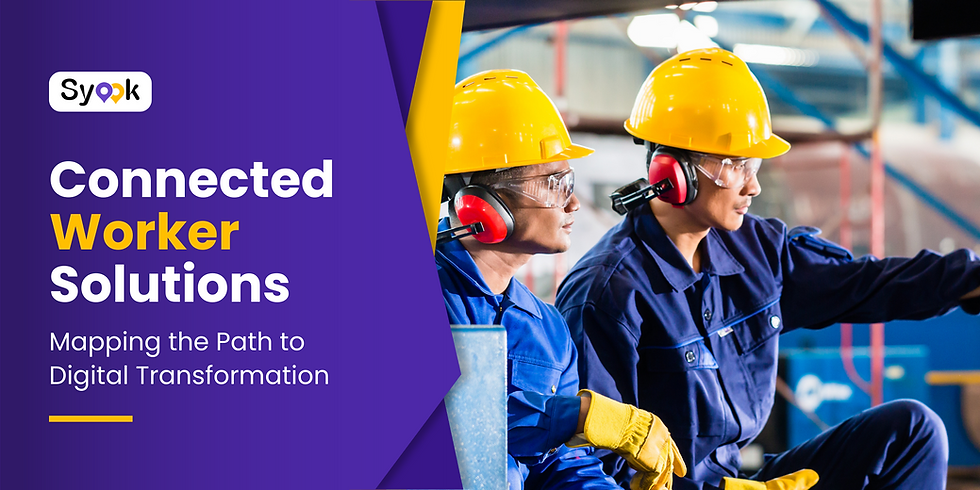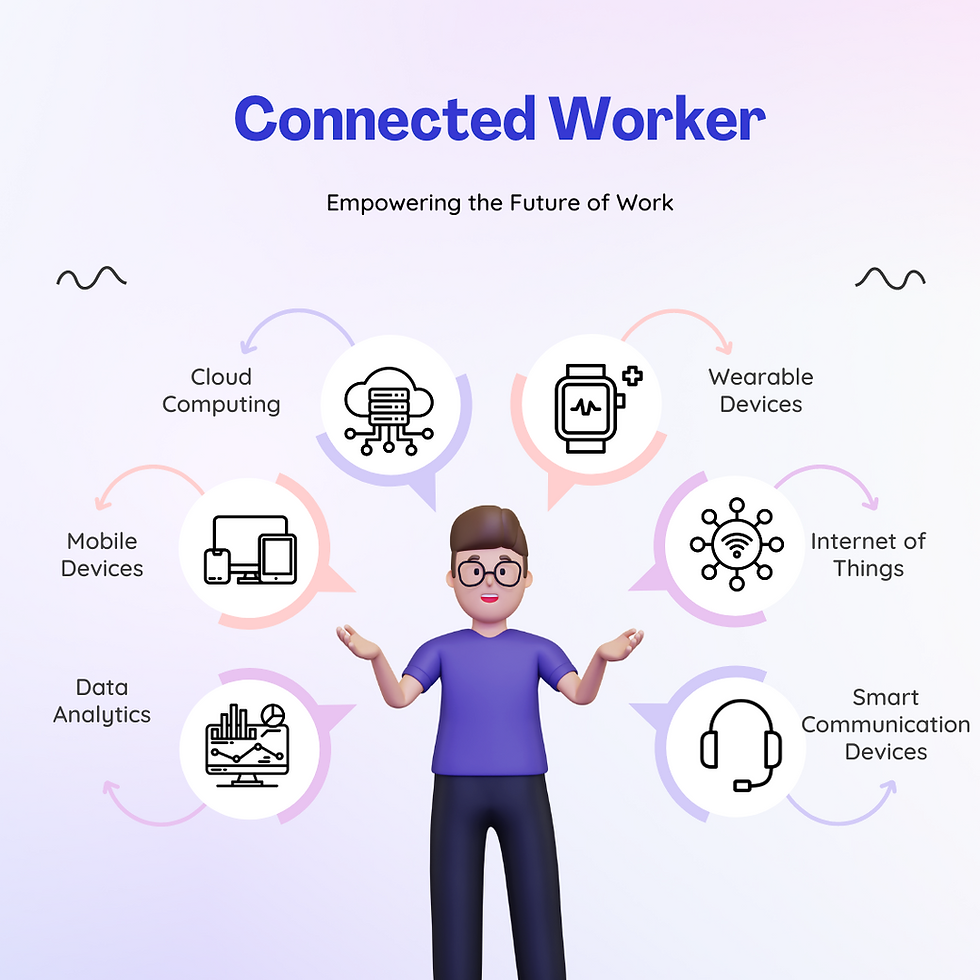In today’s fast-paced industrial landscape, optimizing workforce efficiency and safety is paramount. Enter the Connected Worker Solution, a transformative approach that seamlessly integrates technology, data, and human expertise. By empowering frontline workers with real-time insights, this solution bridges the gap between physical tasks and digital intelligence.

Table of Contents:
What is a Connected Worker?
The Importance of the Connected Worker in the Digital Era
Empowering Manufacturing Excellence: The Connected Worker Revolution
Various Technologies used in Connected Worker
The Advantages of Connected Worker Solutions
How to Choose the Perfect Connected Worker Solution for Your Business
What is Connected Worker ?
In the ever-evolving landscape of modern workplaces, the concept of the connected worker has emerged as a game-changer. But what exactly does it mean to be a connected worker? At its core, a connected worker is an employee equipped with advanced technology, including wearable devices and mobile applications, aimed at augmenting their productivity, safety, and collaborative capabilities within the workplace environment.

These connected worker solutions harness the transformative power of the Internet of Things (IoT) to seamlessly integrate workers, equipment, and systems, creating a networked ecosystem that facilitates real-time communication and data exchange. Whether it's wearable sensors monitoring vital signs for early detection of health issues or mobile apps providing instant access to relevant information and resources, these technologies are redefining traditional work processes and elevating operational efficiency to unprecedented levels.
In this blog, we delve into the intricate world of connected worker solutions, exploring the latest innovations, success stories, and best practices shaping the future of work. From manufacturing and healthcare to construction and logistics, organizations across diverse industries are embracing these transformative technologies to empower their workforce and stay ahead in today's digital era.
The Importance of the Connected Worker in the Digital Era
1. Enhanced Collaboration and Communication:
Communication barriers are broken down in a connected workplace, and collaboration becomes seamless. Employees can collaborate in real-time, regardless of their location or time zone through digital tools such as messaging apps, video conferencing platforms, and project management software. This fosters teamwork, creativity, and innovation, as ideas can be shared instantaneously and diverse perspectives can be easily integrated into decision-making processes.
2. Increased Productivity and Efficiency:
The connected worker has access to a wealth of resources and information at their fingertips, enabling them to work more efficiently and effectively. With cloud-based storage solutions and mobile applications, employees can access work-related documents and applications from anywhere, allowing for greater flexibility and productivity. Moreover, automation tools and workflows streamline repetitive tasks, freeing up time for employees to focus on high-value activities that drive business growth.
3. Empowerment and Flexibility:
Empowering employees to work how, when, and where they are most productive is a hallmark of the connected worker ethos. Remote work arrangements, flexible schedules, and BYOD (Bring Your Own Device) policies give employees greater autonomy and control over their work-life balance. This improves job satisfaction and morale, attracts top talent, and fosters a culture of trust and empowerment within the organization.
4. Adaptability and Resilience:
In a rapidly changing business environment, adaptability is crucial for survival. The connected worker is inherently adaptable, equipped with the skills and mindset to embrace change and navigate uncertainty. Whether it's learning new digital tools and technologies or adjusting to remote work dynamics, connected workers are agile and resilient, capable of thriving in dynamic and unpredictable conditions.
5. Enhanced Customer Experience:
Finally, the connected worker plays a vital role in delivering an exceptional customer experience. By leveraging digital tools and data analytics, employees can gain deeper insights into customer preferences, anticipate needs, and deliver personalized solutions and support. This leads to higher levels of customer satisfaction, loyalty, and advocacy, ultimately driving business growth and profitability.
Empowering Manufacturing Excellence: The Connected Worker Revolution
Who Utilizes the Connected Worker in Manufacturing?
Frontline Workers: At the heart of manufacturing operations are frontline workers—the individuals responsible for assembling products, operating machinery, and ensuring quality standards are met. These workers leverage connected devices such as tablets, wearable devices, and IoT sensors to access real-time instructions, track progress, and report issues instantly. By providing workers with the tools and information they need at their fingertips, the connected worker empowers them to perform their tasks with greater efficiency, accuracy, and safety.
Supervisors and Managers: Supervisors and managers play a critical role in overseeing manufacturing operations and making data-driven decisions to optimize processes and performance. Through connected worker solutions, supervisors can monitor production metrics, track resource utilization, and identify bottlenecks in real time. This enables proactive problem-solving, rapid decision-making, and continuous improvement, driving operational efficiency and cost savings across the manufacturing floor.
Maintenance and Service Technicians: Maintenance and service technicians are responsible for ensuring that manufacturing equipment and machinery are operating at peak performance. Connected worker solutions equip technicians with diagnostic tools, maintenance schedules, and remote monitoring capabilities, allowing them to identify issues before they escalate into costly downtime. By leveraging predictive maintenance and condition monitoring, technicians can perform proactive maintenance tasks, minimize equipment failures, and optimize asset performance.
How Can the Connected Worker be Used in Manufacturing?
Real-Time Production Monitoring: Connected worker solutions enable real-time monitoring of production processes, providing visibility into key performance indicators such as cycle time, throughput, and yield. By analyzing this data in real time, manufacturers can identify inefficiencies, optimize workflows, and maximize productivity.
Remote Assistance and Expert Support: In complex manufacturing environments, workers may encounter challenges that require expert guidance or troubleshooting. Connected worker platforms facilitate remote assistance through video conferencing, augmented reality, and digital collaboration tools, enabling experts to provide real-time support and guidance to frontline workers, regardless of their location.
Training and Skills Development: The connected worker empowers manufacturers to deliver interactive and immersive training experiences to their workforce. Through virtual reality (VR), simulation-based training modules, and e-learning platforms, workers can develop new skills, familiarize themselves with equipment and processes, and improve their performance in a safe and controlled environment.
Safety and Compliance Management: Safety is a top priority in manufacturing, and the connected worker plays a crucial role in ensuring a safe working environment. Wearable devices equipped with sensors can detect hazardous conditions, monitor vital signs, and alert workers to potential risks in real time. Additionally, digital checklists, safety protocols, and compliance workflows help ensure that workers adhere to safety regulations and procedures at all times.
The Advantages of Connected Worker Solutions
Enhanced Productivity: Connected worker solutions streamline workflows, eliminate manual processes, and provide workers with instant access to critical information and resources. By digitizing tasks such as data entry, reporting, and communication, employees can focus their time and energy on high-value activities, driving productivity gains and operational efficiencies
Real-Time Collaboration: In today's fast-paced business environment, collaboration is essential for success. Connected worker solutions facilitate real-time communication and collaboration among dispersed teams, enabling seamless information sharing, problem-solving, and decision-making. Whether employees are working remotely or in the field, they can collaborate effectively and stay connected to colleagues, customers, and partners.
Improved Safety and Compliance: Safety is paramount in any industry, and connected worker solutions play a crucial role in ensuring a safe working environment. Through wearable devices, sensors, and IoT-enabled technologies, employers can monitor workplace conditions, detect potential hazards, and provide workers with real-time safety alerts and guidance. Additionally, digital checklists, safety protocols, and compliance workflows help ensure that workers adhere to regulatory requirements and best practices at all times.
Empowered Workforce: Connected worker solutions empower employees by giving them greater autonomy, control, and flexibility over their work. With access to real-time data, insights, and decision support tools, workers can make informed decisions, solve problems autonomously, and take ownership of their work processes. This fosters a culture of empowerment, accountability, and continuous learning within the organization, driving employee engagement and satisfaction.
Optimized Asset Performance: In asset-intensive industries such as manufacturing, energy, and utilities, connected worker solutions enable predictive maintenance, condition monitoring, and asset optimization. By leveraging IoT sensors, predictive analytics, and machine learning algorithms, organizations can monitor equipment health, identify potential failures before they occur, and optimize maintenance schedules to maximize asset uptime and reliability.
Enhanced Customer Experience: Ultimately, the benefits of connected worker solutions extend beyond the organization to the customer. By improving workforce productivity, safety, and efficiency, businesses can deliver a superior customer experience characterized by faster response times, higher service quality, and increased customer satisfaction. Whether it's delivering products faster, resolving issues more effectively, or providing personalized service, connected worker solutions help businesses exceed customer expectations and drive loyalty.
How to Choose the Perfect Connected Worker Solution for Your Business
In today's fast-paced and digitally driven world, businesses are constantly seeking ways to enhance productivity, efficiency, and safety in the workplace. But with a plethora of connected worker solutions available in the market, how do you choose the right one for your business?
Identify Your Business Needs and Goals: Before diving into the selection process, take the time to identify your business needs, goals, and objectives. Determine what specific challenges or pain points you're looking to address with a connected worker solution. Whether it's improving workforce productivity, enhancing safety protocols, or optimizing asset management, having a clear understanding of your priorities will guide your decision-making process.
Evaluate Features and Functionality: When evaluating connected worker solutions, consider the features and functionality that are essential for your organization. Look for solutions that offer real-time communication tools, task management capabilities, remote monitoring functionalities, and integration with existing systems and platforms. Assess whether the solution aligns with your workflow processes and can seamlessly integrate into your existing infrastructure.
Consider Scalability and Flexibility: As your business grows and evolves, your connected worker solution should be able to scale and adapt to changing needs and requirements. Choose a solution that offers scalability and flexibility, allowing you to add new users, functionalities, and modules as needed. Additionally, consider whether the solution supports a diverse range of devices and operating systems to accommodate different user preferences and work environments.
Ensure Data Security and Compliance: Data security and compliance are paramount when implementing a connected worker solution. Look for solutions that prioritize data encryption, user authentication, and compliance with industry regulations such as GDPR, HIPAA, or ISO standards. Verify that the solution adheres to stringent security protocols and offers robust data protection measures to safeguard sensitive information and mitigate cybersecurity risks.
Assess User Experience and Adoption: The success of a connected worker solution hinges on user adoption and engagement. Prioritize solutions that offer an intuitive user interface, seamless user experience, and comprehensive training and support resources. Conduct pilot tests or demos to gauge user feedback and ensure that the solution meets the needs and preferences of your workforce.
In conclusion, choosing the perfect connected worker solution is essential for businesses looking to thrive in today's digital era. By prioritizing factors such as scalability, security, and user experience, organizations can empower their workforce, drive efficiency, and achieve their business objectives.
At Syook, we understand the critical role of connected worker solutions in enabling operational excellence and driving business success. Our comprehensive suite of connected worker solutions is designed to address the unique needs of businesses across various industries.

Comments